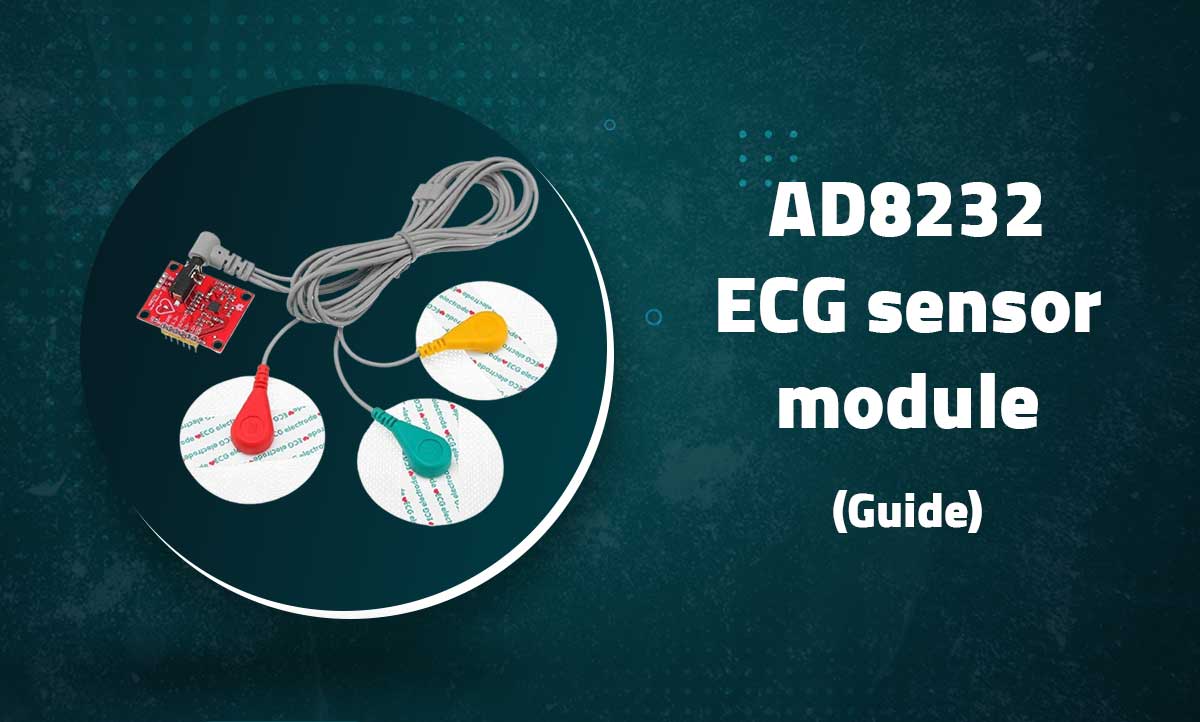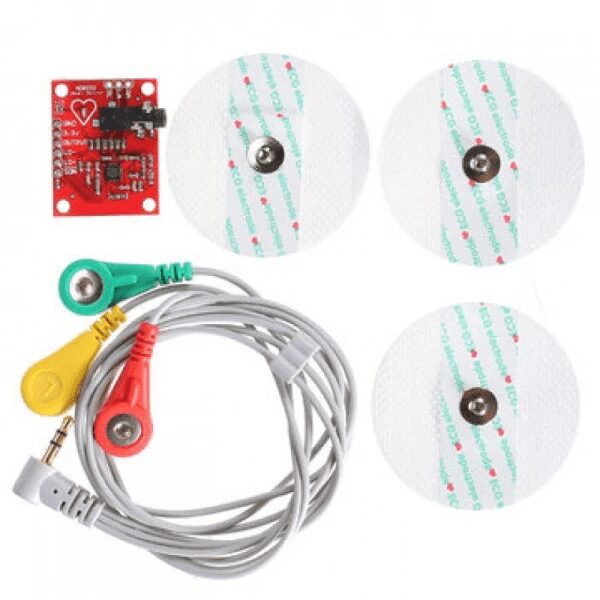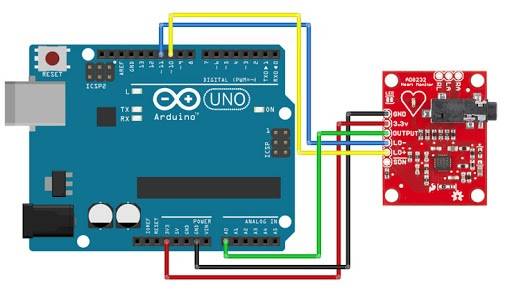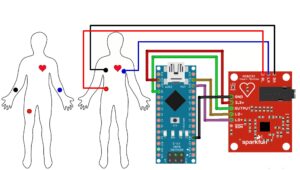Heart Rate Monitor Kit with AD8232 ECG sensor module

AD8232 ECG Heart Rate Monitor Kit
Professional-Grade Biopotential Measurement for Arduino and Medical Applications
Introduction
The AD8232 ECG Sensor Module is a compact board that measures electrical activity of the heart. This single-lead ECG front end is designed for portable, low-power applications and works perfectly with Arduino for heart rate monitoring projects.

Key Features
Medical Grade
Single-lead ECG monitoring
High Precision
Integrated signal conditioning
Low Power
170μA typical current consumption
Lead-Off Detection
Built-in electrode contact monitoring
Technical Specifications
| Input Range | ±1.5mV to ±100mV |
|---|---|
| Bandwidth | 0.5Hz to 40Hz |
| Gain | 100 V/V (adjustable) |
| Supply Voltage | 3.0V to 5.5V |
| Output Type | Analog (ECG signal) + Digital (LO+/LO-) |
| Electrodes | 3x Snap-on (RA, LA, RL) |
Pin Configuration

| Pin | Label | Description | Arduino Connection |
|---|---|---|---|
| 1 | 3.3V | Power (3.3V recommended) | 3.3V |
| 2 | GND | Ground | GND |
| 3 | OUTPUT | ECG Analog Output | A0 |
| 4 | LO+ | Lead-Off Detect Positive | D11 (Digital Input) |
| 5 | LO- | Lead-Off Detect Negative | D10(Digital Input) |
| 6 | SDN | Shutdown Control | D4 (Optional) |
Important: Proper electrode placement is crucial for accurate readings
Electrode Placement

Standard Lead I Configuration:
- RA (Right Arm): Right side of chest
- LA (Left Arm): Left side of chest
- RL (Right Leg): Ground reference
For best results, clean skin and use conductive gel
Basic ECG Monitoring
// AD8232 ECG Basic Monitoring
const int ecgPin = A0;
const int loPlus = 2;
const int loMinus = 3;
void setup() {
Serial.begin(9600);
pinMode(loPlus, INPUT);
pinMode(loMinus, INPUT);
}
void loop() {
if((digitalRead(loPlus) == 1 || (digitalRead(loMinus) == 1)){
Serial.println("Electrode disconnected!");
}
else {
int ecgValue = analogRead(ecgPin);
Serial.println(ecgValue);
}
delay(10);
}
Processing Visualization: Use Serial Plotter or Processing IDE for ECG waveform display
Advanced Features
Heart Rate Calculation
// Detect R-peaks and calculate BPM
unsigned long lastBeat = 0;
float threshold = 520; // Adjust based on signal
float bpm = 0;
if(ecgValue > threshold && millis() > lastBeat + 200){
bpm = 60000 / (millis() - lastBeat);
lastBeat = millis();
Serial.print("BPM: "); Serial.println(bpm);
}Signal Filtering
// Simple moving average filter
#define FILTER_SIZE 5
int filterBuffer[FILTER_SIZE];
int filterIndex = 0;
int filteredValue = 0;
filterBuffer[filterIndex] = ecgValue;
filterIndex = (filterIndex + 1) % FILTER_SIZE;
for(int i=0; i<FILTER_SIZE; i++){
filteredValue += filterBuffer[i];
}
filteredValue /= FILTER_SIZE;SD Card Logging
// Log ECG data to SD card
#include
#include
File ecgFile;
void setup(){
SD.begin(4); // CS pin
ecgFile = SD.open("ecg.csv", FILE_WRITE);
}
void loop(){
ecgFile.print(millis());
ecgFile.print(",");
ecgFile.println(ecgValue);
}Bluetooth Streaming
// Stream ECG via Bluetooth
#include
SoftwareSerial btSerial(10, 11); // RX, TX
void setup(){
btSerial.begin(9600);
}
void loop(){
btSerial.println(ecgValue);
delay(10);
}Troubleshooting
Noisy Signal
- Ensure proper electrode contact
- Keep away from power cables
- Add RC low-pass filter (10kΩ + 0.1μF)
Flatline Reading
- Check electrode connections
- Verify power supply (3.3V recommended)
- Test with different electrode positions
False Alarms
- Adjust detection threshold
- Implement software debouncing
- Check for muscle movement artifacts
Related Posts
IC 74173 – 4-Bit D-Type Register with 3-State Outputs
IC 74173 - 4-Bit D-Type Register with 3-State Outputs
TTL Quad D Flip-Flop with Asynchronous Clear and Output Enable
...
DIY Metal Detector Kit
DIY Metal Detector Kit
DC 3V-5V Non-Contact Sensor Module with 60mm Detection Range
Introduction
The DIY Metal Detec...
CNC V3 Shield with 4 A4988 Drivers
CNC V3 Shield with 4 A4988 Drivers
Complete Arduino-compatible CNC controller for 3D printers and milling machines
...
CN3791 12V MPPT Solar Charger Module
CN3791 12V MPPT Solar Charger Module
Maximum Power Point Tracking Solar Charge Controller for Lead-Acid/Lithium Batteries
...
CJMCU-TRRS 3.5mm Jack AV Stereo Module
CJMCU-TRRS 3.5mm Jack AV Stereo Module
Compact breakout board for audio/video signal interfacing with TRRS connectors
...
TTP223 Capacitive Touch Sensor Module (Red)
TTP223 Capacitive Touch Sensor Module (Red)
Single-Key Touch Detection with Digital Output for Arduino and DIY Projects
...



Recent Comments